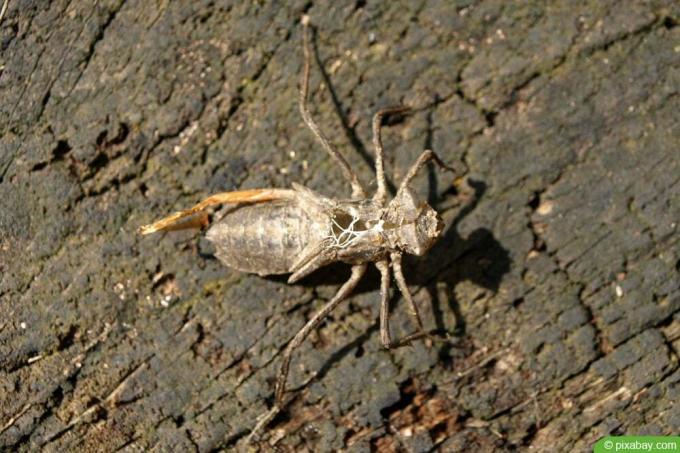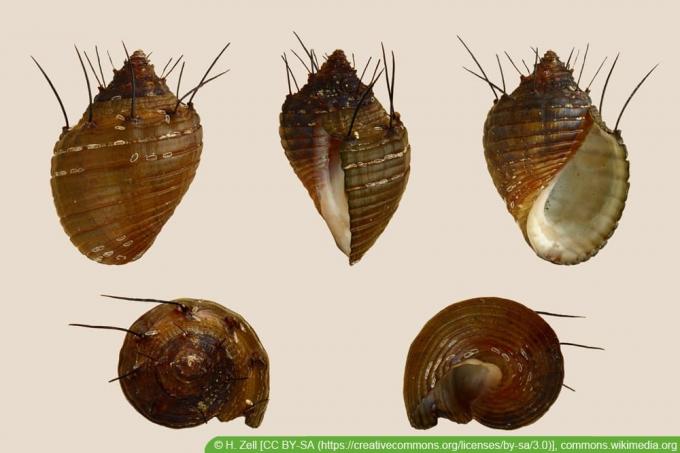

Table of contents
- Nutrition in the larval stage
- hunting behavior
- Food of adult dragonflies
- Reproduction and oviposition
- Laying eggs on the water surface
- Laying eggs under water
If dragonflies have used the pond in the garden to lay their eggs, that is an advantage on the one hand. Because the predatory insects use, for example, the larvae of other insects as prey. However, their diet consists not only of pests, but can also include beneficial insects. Nevertheless, every garden owner should be happy about dragonfly larvae in the garden pond and set up the water body appropriately.
Nutrition in the larval stage
Mosquito larvae are the main food of dragonfly larvae. Therefore dragonflies are extremely useful even in the larval stage. You can prevent a real mosquito plague in the garden and should be welcomed in your own green. In addition to the mosquito larvae, the diet of the dragonflies in the larval stage also consists of other insects and other animals. These are:
- smaller fish
- Insects that fell into the water
- tadpoles
- larvae of other insects
- water fleas
- water strider

The larvae of dragonflies can be harmful to fish and tadpoles in particular. However, this only affects the larvae of large species, and even then they only become a potential threat when they are close to the adult – i.e. mature – stage. Even then, however, the preferred food is the mosquito larvae, so there is no need to expect that other beneficial insects will be reduced too much. There is rarely a large number of dragonfly larvae in a pond, so there is no need to worry.
hunting behavior
The larvae of the dragonflies lie in wait for their prey and seize it with the so-called trapping mask. The catch mask is a kind of extended lower lip. Normally, this cannot be seen because it is folded in when it is not in use. She can only be seen when she is eating. Since the larvae are lurking hunters, they need the right environment in the garden pond. The design of the pond therefore plays a major role.
Food of adult dragonflies
Dragonflies are predatory. That means they eat other insects. These include, for example:
- mosquitoes
- gnats
- Fly
- butterfly
- other dragonflies
Eating other dragonflies may seem strange at first from a human perspective. However, it brings some benefits to the dragonflies. On the one hand, this is a simple form of food source. Since the insects, which are harmless to humans, know the behavior of their fellow insects, hunting is easier. So you have to expend less energy to feed yourself. On the other hand, the dragonflies thereby reduce their competition. As a result, they create more favorable conditions for themselves, since there are fewer predators - and at the same time they find more prey.

What is environmentally beneficial about the predatory behavior of adult dragonflies and their larvae, however, is that on the one hand a balance is struck. As long as the dragonflies find enough mosquitoes, flies and mosquitoes, for example, they will not attack their own kind. This prevents plagues and the pests do not die out, but their numbers are reduced. As a result, further and possibly more dangerous control measures can be dispensed with. At the same time, the dragonflies also prevent their own numbers from rising to unfavorable heights. Decimating other insects is also controlled and a balance can be established.
Reproduction and oviposition
Depending on the species, adult dragonflies have different ways of reproducing or laying eggs. Basically, there are only two different variants.
Laying eggs on the water surface
The female dragonfly lays the fertilized eggs directly above the water surface. The preferred storage place is the stems and leaves of riparian or aquatic plants. Another variation is that the dragonflies drop the eggs. The eggs sink into the pond and remain on the bottom until the larvae hatch.
Laying eggs under water
In some cases, the female or both females and males dive under water and lay their eggs here. Plants are the preferred places to put them.
Tip:
In both cases it is important that appropriate plants are available. Because these serve as a storage place and later for the larvae as protection and as a hiding place for the lurking hunt. It is optimal to bring in different plants from the bank area to the bottom of the pond. As a result, different dragonfly species can settle in the garden pond, hide here and go hunting. In addition, adult dragonflies only lay eggs if the habitat suits their needs. This is also determined by the pond design.
 Home editorial office
Home editorial office
Learn more about pond animals

Marsh snail in the pond | 9 Posture Tips
Of the nearly 100,000 species of snails, only about 40 live in freshwater. The mud snail is one of the ten species that can also be found in a pond. It inhabits the bottom of the body of water and contributes significantly to cleaning it there.

Swimming pond with fish: This is how the combination works
A swimming pond with fish can be a very special highlight in the garden. However, the fish pose special challenges because the nutrient content of the water is significantly increased. However, the combination is possible with an appropriate structure and comprehensive filtering.

Tower snails | 13 tips for keeping & propagation
Tower snails are particularly popular aquatic animals in garden ponds - at least as long as they don't multiply endlessly. They also signal in aquaria whether optimal conditions exist. Tips for husbandry and propagation create an improved habitat without mass propagation.

Keeping pond mussels in the garden pond | 9 Posture Tips
The trend towards natural garden ponds has been unbroken for years. Many garden owners use it to create their own small wet biotope. However, this is not possible without appropriate stocking with plants, small fish and pond mussels.

Keeping Sunfish in the Pond | 7 tips on husbandry & feed
Perch are predatory fish and therefore rather unsuitable for pond keeping. An exception, however, is the magnificent bluegill, which usually gets along well with other fish. Here is what you need to pay attention to when keeping it.

Feed pond fish: from when and how often are fish fed?
Anyone who has created a pond with fish in their own garden inevitably asks themselves whether the Fish need to be fed and if so, when is the best time to do so and how much food is given should.


